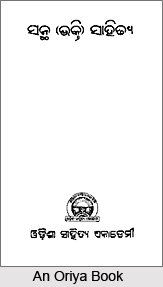 History of Oriya literature has contributed immensely to the over all field of performing arts of Orissa. Usually all the languages of eastern India claim their ancestry to the Charyagitis (8th century A.D. to 11th century A.D.). These were written by Buddhist Sidhas. These Charyagitis were discovered in Nepal and Tibet in early 20th Century. They were written in eastern Apabhramsha language, which was called Prakrit by commentator Munidutta. Many modern languages like Oriya language, Bengali language, Assamese language, Maithili language, Magadhi language and Bhojpuri language emerged from this eastern Apabhramsha. Hence all these modern languages try to discover their earliest origin from this language. Historians of Oriya language and literature also trace the earliest origin of Oriya from selected Charyagitis. Even some Bengali critics like Bijay Chandra Majumdar hold the view that the language of some of the Charyas was ancient Oriya.
History of Oriya literature has contributed immensely to the over all field of performing arts of Orissa. Usually all the languages of eastern India claim their ancestry to the Charyagitis (8th century A.D. to 11th century A.D.). These were written by Buddhist Sidhas. These Charyagitis were discovered in Nepal and Tibet in early 20th Century. They were written in eastern Apabhramsha language, which was called Prakrit by commentator Munidutta. Many modern languages like Oriya language, Bengali language, Assamese language, Maithili language, Magadhi language and Bhojpuri language emerged from this eastern Apabhramsha. Hence all these modern languages try to discover their earliest origin from this language. Historians of Oriya language and literature also trace the earliest origin of Oriya from selected Charyagitis. Even some Bengali critics like Bijay Chandra Majumdar hold the view that the language of some of the Charyas was ancient Oriya.
The Charyas, written in an obscure and mysterious language are highly mystical in essence, and highly poetical and musical in form. They were sung in religious congregations.
 Hence the Raaga in which each Charya is to be sung is fixed and indicated. The following Raagas were used in the Charyas: Pattamanjari, Gauda, Malasri, Gauda, Mallari, Gunjari, Gujjari, Ramkri, Desakhya, Bhairavi, Kamada, Baradi, Sabari, Aru, Debakri, Dhanasri, Bangala and Indratala, Sarngadev mentions in his `Sangeet Ratnakar` that the Charyas were accepted as a special kind of music. Out of 18 Raagas described in `Boudhagana O Doha` 15 Raagas also find mention in `Geeta Prakash` and `Sangeeta Narayan`, two ancient musical treatises of Orissa.
Hence the Raaga in which each Charya is to be sung is fixed and indicated. The following Raagas were used in the Charyas: Pattamanjari, Gauda, Malasri, Gauda, Mallari, Gunjari, Gujjari, Ramkri, Desakhya, Bhairavi, Kamada, Baradi, Sabari, Aru, Debakri, Dhanasri, Bangala and Indratala, Sarngadev mentions in his `Sangeet Ratnakar` that the Charyas were accepted as a special kind of music. Out of 18 Raagas described in `Boudhagana O Doha` 15 Raagas also find mention in `Geeta Prakash` and `Sangeeta Narayan`, two ancient musical treatises of Orissa.
Kapilendra Dev established the Surya dynasty. It was during his regime (1415-1568 A.D.) that Sarala Das wrote a popular Oriya version of `Mahabharata`. He is popularly known as Adi Kabi (first poet) and Shudra Muni (Shudra poet). Though Oriya language and literature had developed before Sarala Das, they attended full-blown stage only during Sarala`s time. What added local flavour to this national epic is his use of colloquial Oriya of the time and the various local folk tales in which the text was grounded. The `Chandi Parana`, also written by Sarala Das referred to Yoginis. Yoginis are Tantric Goddess. It was written under the influence of Yogini cults.

Balarama Das`s translation of `Ramayana` is as famous as Sarala`s Mahabharata. He was the eldest Sakha or friend among the famous `Pancha Sakhas` (five friends), other four being Jagannath, Achyutananda, Yasobanta and Ananta. The five poets were all very humble people from the lower social strata, and by birth and upbringing belonged to the working classes. Jagannath Das was the second among the `five friends`. He transcribed the Srimad Bhagabattam in Oriya. It is said that the Pancha Sakhas were the contemporary of Chaitanya. They have produced devotional literature. Achyutananda is also considered the `Nostradamus of Orissa.`
The medieval period of Oriya literature followed the above said Bhakti Period. The literary corpus of the middle ages is very rich in its content. Odissi music has adopted as Bandish most of the songs of the Middle Ages. Uppendra Bhanja (1680 - 1720 A.D) was the most eminent poet of this period. He was also a rhetorician. His style is heavily ornamental and the depiction is very often erotic. His famous Kavyas are `Lavanyavati` and `Baidehisabilasha`. In each Kavya, he has indicated the Raagas and Talas. He has also composed Chhanda, all set to specific Raagas or Brutas.
Gangadhar Meher, Madhusudan Rao, Laxmikanta Moluipatra are some poets of the late 19th and early 20th century whose poetry has been adopted for musical purpose. With the advent of modern theatre and electronic media lyricists have emerged as a separate breed. Kalicharan Pattanaik, Narayn Prashad Singh, Gurukrishana Goswami, Akshya Mohanty and Debdas Chhotray are some of the trendsetters as far as modern lyrics used in the media are concerned.
Given above is therefore a brief history of Oriya literature.













